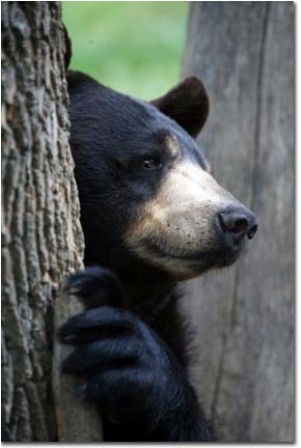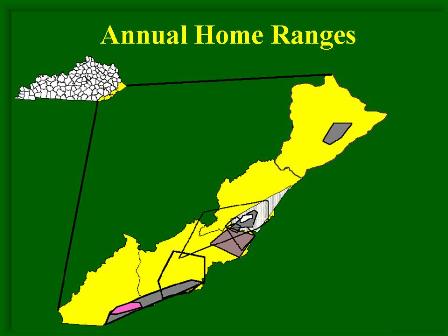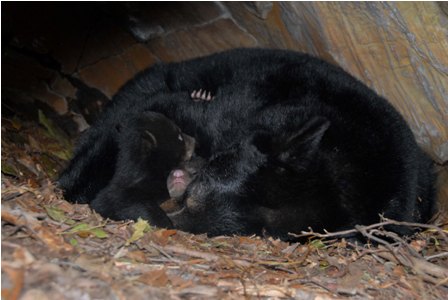By Carrie Stambaugh
ASHLAND The Black Bear population is healthy and growing in eastern Kentucky, says the state’s top bear biologist.
He predicted more residents will come into contact with the animals in coming years as their range continues to expand and that bear hunting season and bag limits will also be increased.
Steven Dobey is the program coordinator of the Kentucky Department of Fish and Wildlife’s state-wide bear program. It began in 2002 primarily to track and document the occurrence and range of bears in Kentucky but has expanded its mission to include the social dynamics of coexisting in habitats with people.

Dobey said the decade of research has determined that bears live in all of Kentucky’s easternmost counties stretching from McCreary County in the south to Lewis County in the north and eastward along the borders of Tennessee, Virginia and West Virginia.
However, the highest concentrations of bear are found along the Pine Mountain Corridor in Bell Harlan, Letcher and Pike counties but the number of bears in McCreary County, particularly inside the Big South Fork National River and Recreation Area, “has really taken off in the last four years,” said Dobey. He added that research has found the bears in McCreary County are genetically distinct from those along the Pine Mountain corridor having descended from a separate subpopulation than their easternmost cousins.
“All these bears we have are from natural range expansion,” Dobey said dispelling a popular myth. “We did not stock bears in Kentucky unlike turkeys, river otter, and elks. We did not restore these they did it on their own.”
Black bears, he said are the only big game species in Kentucky that have naturally returned from low numbers without assistance from the KDFWR, or any other wildlife agency. This makes bears “a true wildlife success story.”
Dobey estimated Kentucky has less than 500 black bears – far fewer than the populations in its neighboring southern Appalachian states – but that number is rising, albeit slowly.
“Bears have one of the slowest reproductive rates of all large mammals. People, they want to associate them with deer, turkey and elk (populations) that explode and go everywhere but bears just aren’t like that – their reproductive rates are very, very slow,” he said.
Based on the KDFWR’s research, which is conducted in a cooperative project with the University of Kentucky’s forestry graduate program, the bear population is expected to expand from the Pine Mountain area northward through the mountainous habitat over the coming decades.

“Bears need oak forests to survive and prefer sparsely populated areas,” Dobey said. “How far they can expand,” he added, “depends on the availability of habitat as well as the social carrying capacity. Bears can only live where they are tolerated.”
Dobey believes bears will stay inside the eastern mountain region but expand northward toward the Ashland area. Populations inside the northern areas of Daniel Boone National Forest will also likely continue to grow. Bears can already be found in these areas, he said, but the numbers are currently low.
As they increase, so will the number of sightings and incidents involving people, Dobey said.
In fact, the KDFWR has become more focused on addressing the social dynamics of people and bears in recent years, with the ultimate goal of the program being to manage the bear population by balancing biological considerations with the interest of human residents.

Education will be a key component in that balance, Dobey said.
“People who don’t deal with them are almost innately afraid of them,” said Dobey. “When it comes to bears, they are very reclusive animals. They don’t tend to hang around in a natural setting. Wild bears want nothing to do with people but black bears are like other species, when they get in and around food sources they become tolerant of people,” he added.
“That is the main thing we have to deal with, is limiting a bears access to human related food – garbage, dumpsters, and being fed. Eliminating or minimizing that component will remove almost all and any issues that would come up,” Dobey said.
The No. 1 bear attractant is garbage but there are other simple things that attract bears, particularly in June and July during the height of breeding season when male bears move across large areas looking for mates or trying to avoid other male bears. “Bird feeders are a simple snack for bears and pet food is another big one,” he said.
Educating the public on proper trash disposal and storage of food items will also become more important in recreation areas, he said, particularly as word gets out that bears are there and visitors come just for a chance to see and photograph them.
“The worst attractant is people feeding bears and that really becomes important in campgrounds,” said Dobey. “Everyone wants to get pictures – what is the best way to keep the bears there? Toss them one donut but it doesn’t take long and they will start associating that food with people and they will begin approaching people in hopes of getting a reward,” he said, adding “that never ends up good. Usually it ends up with a bear getting shot or wandering on to a roadway.”

As their numbers and range grow, the data collected by bear researchers will become even more important in determining what role hunting will play in their management, Dobey said.
Kentucky’s first bear season in 100 years was held in 2009 but no bears were taken. In 2010, hunters killed two male bears.
“As our continued research and associated data indicate that our bear population can sustain increased hunting mortality we do plain to liberalize the season,” he said. “This could include adding counties to the Bear Zone in which bear hunting occurs, lengthening the duration of the season, increasing the bag limit, or amending season dates,” he said. Any decision will be based largely on sound scientific research, he added.

In fact, hunters are the largest supporters of bear research in Kentucky, Dobey pointed out.
Approximately 50% of the bear program’s annual operating budget of approximately $90,000, is acquired solely from the sale of hunting, fishing, and trapping licenses within Kentucky and another 36% of the budget comes from federal-based grants, which are also funded by the sale of hunting and fishing licenses.
The remaining funding comes from boating-related fees and miscellaneous sources not related to state tax contributions, Dobey said, adding that KDFWR receives no funding whatsoever from the state’s general fund.
Carrie Stambaugh can be reached at carriestambaugh@gmail.com.


i walked up on a bear at cumberland falls at the gift shop at about 22 oo hundred hours in august . i fell back wards and the bear stood up after a few minets it droped don on all fours and ran , idis to when i got up and headed for the car.. i have lived in hat area for yers this is the frist time i saw a bear at the falls
We had a bear raid on our garbage cans here in my neighborhood in Perry Co., Ky. A few nights ago. Will we be forced to change the way we store our garbage? I think some people would be very resistant to this idea.
I live near the South Fork of the Red river. and have had a continuing relationship with a black bear since spring. The area directly behind my house is narrow steep holler running east to west, with a creek at the bottom of canyon like hills of white oak , hickory, and virgin hemlock, The south side shady and cool with thick laurel and hemlock trees line steep sandstone and limestone out crops, in other words perfect bear home. Ive been tracking its trails with in 200 yrds perimeter of the house and have found lots of sign. It began when it got in my garbage cans a few months ago. I set up my trail cam and sure enough about a month later he came back and the camara got a few good pics, i placed my cans in the garage and hadn’t seen him for a while, but he was there and I just didn’t know it . Ive found tree marks, beds, scat and best of all some good tracks just a few days ago about fifty yards from my house that led to a well worn day bed at the edge of woods overlooking a field where my neighbor had a dear feeder. Then I set out to recon and see if I could get on his trails. Having no experience tracking bears I just looked for the sign that was new and from something other than the wildlife sign I normally see, like deer, coyote, etc. It didn’t take long at all to find fresh and older sign. The next step is to recon the ridgelines and the hemlock cliff zones with countless den sites. I am not hunting the bear but I do want know its habits and maybe do something to keep it up in the hills and away from my family. I am pretty good at tracking , but no experience with bears and am looking for the basic tips on their habits and habitat. I did notice one thing , they seem to travel in a somewhat straight line to their objective, from food source to beds. This is of course what Ive seen with this bear, may not mean anything. However in the woods the trail did seem to meander about from dead trees torn open for grubs and such, to dug out places at the foot of standing dead rotting trees, but still in a general direction. Again this may not mean anything but Im looking for any unusual sign. There is something about looking for a bear that kind of gets the adrenaline going. My stepdaughter and I went along the trails close by the house , but I think I should get a more experienced partner before I go back on the mountain. So far he has pooped in my yard , tore up my trash twice and marked a tree with his claws, and at least one very fresh day bed within 25 yrds of my yard. I have removed the food source but he still likes our company. If that’s all he does I got no complaints, I just hope he behaves himself. Some folks around here will probably not give him a second chance. He has a wonderful habitat back up in that deep holler, with food water and shelter all year, if he stayed up there no one would even know he was there. Any serious advice would be appreciated , especially on what not to do. Thanks
Three bears live on our property in liberty kentucky. One big male one female and one younger. That sit and watch us. That is also two panthers that havd been seen. Makes life different now to go and walk around in the woods.
Burrel Smither